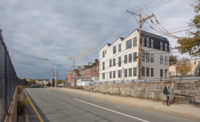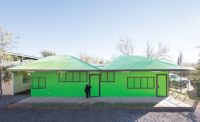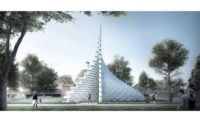Granada, Spain
Born-and-bred granadinos, Javier Castellano Pulido, 41, and Tomás García Píriz, 38, first met in the early 2000s while studying at the Escuela Téchnica Superior de Arquitectura de Granada. Now they are professors, practitioners, and Ph.D.s, and the influence of their historic home base is evident in their built work and research. “Granada shapes our way of looking at the world,” says García Píriz. “It’s not Madrid or Barcelona; it belongs to the periphery, and gives us both distance from and perspective on the rest of the architecture scene.” Referencing Italo Calvino’s Invisible Cities, which represents Venice as the perfect distillation of all cities, Castellano Pulido explains, “We like to think the same of Granada. We find many layers of different cultures, different histories, mixed together here.”
The duo established CUAC in 2008—the same year they participated in the 11th annual Venice Architecture Biennale. For the Spanish Pavilion, they exhibited plans (created prior to formally joining forces) for an adaptive reuse project: the headquarters of ARENA Media in Madrid, which was built in 2010. “Introducing a new trendy office in an old building was a fairy tale for us,” says Castellano Pulido. “We love doing work over work—that is, work in already built structures,” adds García Píriz. Since then, the firm’s designs have consistently taken a thoughtful approach to examining and showcasing the heritage of each project, utilizing existing structures, materials, or histories to enhance the program.
When it comes to their firm’s name, Castellano Pulido and García Píriz are hard pressed to give a straight answer: “The concept of CUAC is related to serendipity or coincidence—the unseen surprises of architecture,” says Castellano Pulido. “And it’s the sound that a duck makes,” he adds. García Píriz tries out another explanation: “It’s related to memory, to childhood tales . . . and it’s sort of an inside joke,” he says. Finally Castellano Pulido concedes, “It’s a secret.”
The architects point to their own offices as an example of their namesake concept in action. Originally a mortuary and later an internet café, the old brick building on San Jerónimo street in the historic center of Granada offered myriad histories and materials for the architects to incorporate. They reused broken bricks and chunks of plaster, salvaged painted wood for shelving, and brought in a heavy metal door from their previous office to spiritually link their new and old workspace. It was only after completing the project that Castellano Pulido and García Píriz recognized the uncanny resemblance between their new office and a Baroque painting they had shown many times to their students as an example of “creating one space inside another.” The painting? Saint Jerome (or, in Spanish, San Jerónimo) in His Study, by Hendrick van Steenwijck the Younger. “That is CUAC,” they agree.
CUAC Arquitectura
FOUNDED: 2008
DESIGN STAFF: 10
PRINCIPALS: Javier Castellano Pulido, Tomás García Píriz
EDUCATION: Castellano Pulido: Escuela Técnica Superior de Arquitectura de Granada (ETSAGR): Ph.D., 2015; Advanced Studies Diploma, 2005; M.Arch., 2001. García Píriz: ETSAGR: Ph.D., 2016; Advanced Studies Diploma, 2006; Universidad Politécnica de Madrid, Advanced Studies Diploma, 2005; ETSAGR, M.Arch., 2003
WORK HISTORY: Castellano Pulido: Instituto del Patrimonio Turístico, Universidad Central de Chile, 2011–12; Escuela Técnica Superior de Arquitectura de Málaga, 2010–present; City of Salobreña, Granada, 2005–07; Studio Mesones-57, 2001–07. García Píriz: Tsukamoto Lab (Atelier Bow Wow), Tokyo Institute of Technology, 2007–08; ETSAGR, 2005; Studio 4:33, 2003–07
KEY COMPLETED PROJECTS: Physical Therapy Clinic, 2016; San Jerónimo 17, 2015; GABBA HEY, 2015; Harvest House, 2014; Biodiversity Centre, 2011; Magdalena’s Fountain, 2009; ARENA, Madrid, 2007 (all in Granada, Spain, except as noted)
KEY CURRENT PROJECTS: Planta Baja Music Club, Granada, 2016; “CUAC Arquitectura: San Jerónimo y Alrededores” (exhibition), Colegio Oficial de Arquitectos de Jaén, 2017; Beas Rural House, Granada, 2017 (all in Spain)












Post a comment to this article
Report Abusive Comment